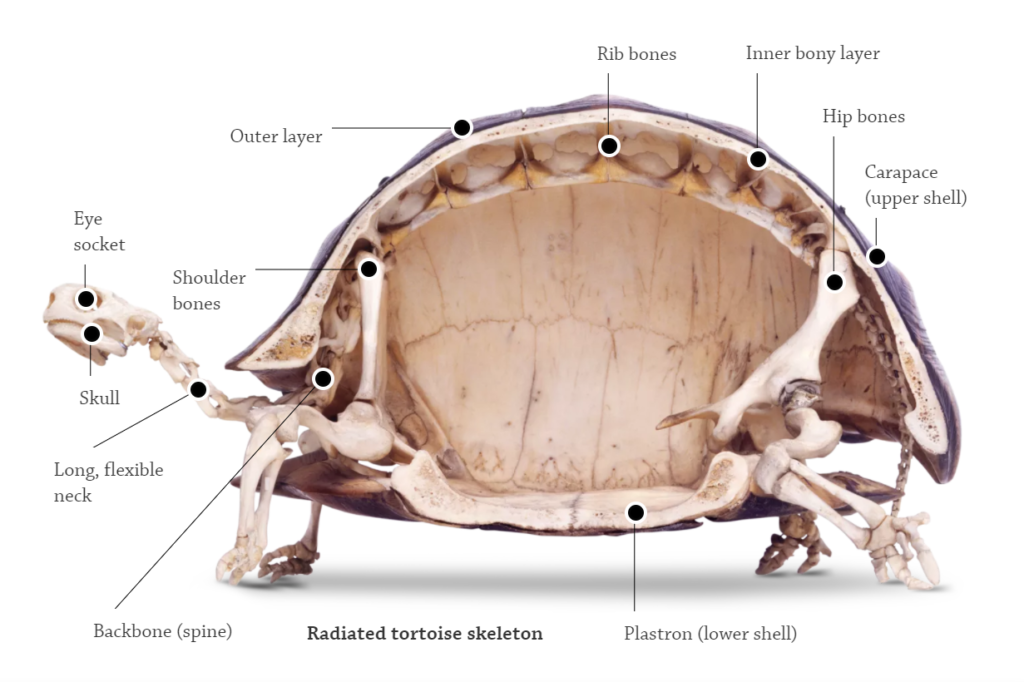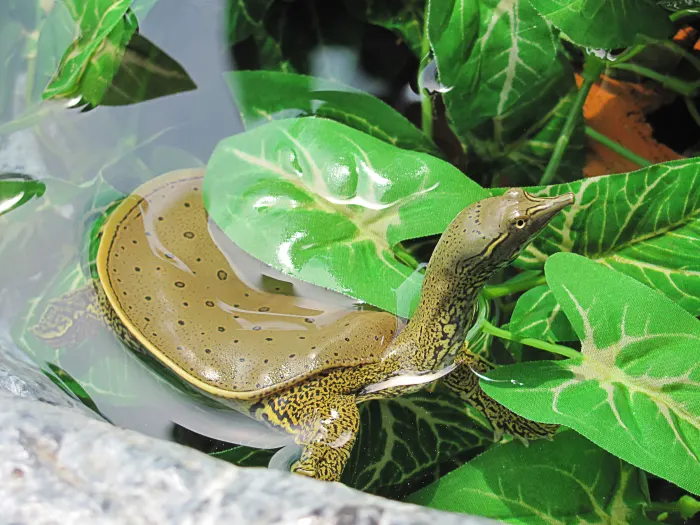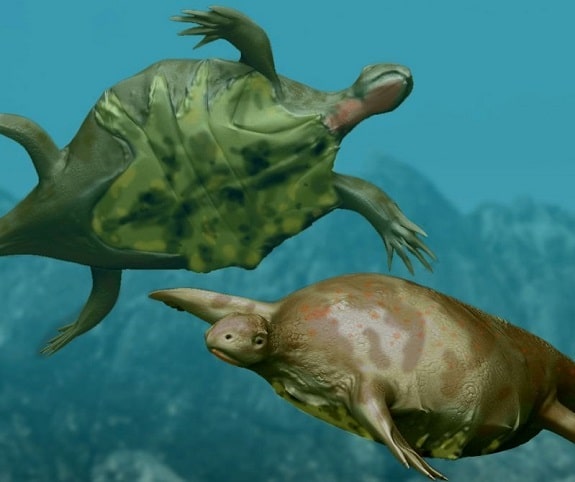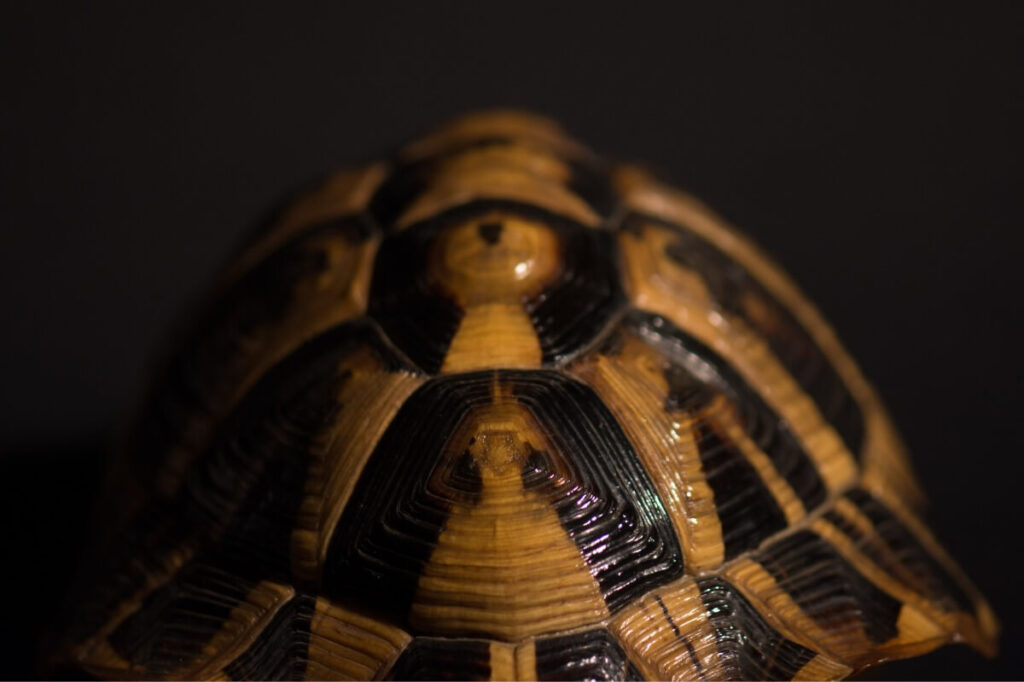A turtle without a shell can not survive as it’s not just its protective gear but also a part of its body. We all are aware of how turtles use these shells as protection against predators, hunters, the environment, and other dangers. But can turtles live without their shell? No.
Unlike the general perception that turtles’ shells are like the ones of snails and other animals, their shells are their pressed ribs and only turtles and tortoises have shells as a body part. The shells of turtles play a crucial part in survival and provide support to multiple biological processes in their body.
If you have a pet turtle or you are interested in keeping one, you must understand the importance of the shell and how to care for it if it gets damaged. In this detailed guide, you’ll get to know anything and everything about a turtle’s shell.
Turtle Shells Explained: The structure of the Turtle Shell and its Importance

The structure of a turtle’s shell is comprised of two important parts that are carapace and plastron fused together on each side of a bridge. The carapace is the top part of the turtle mostly referred to as a shell while the Plastron is the bottom part of the shell and can also be taken as the turtle’s belly.
The carapace is covered with scutes (scoots) made of keratin, just like human nails and hair. The spinal column and rib bones are part of the carapace while the plastron of the turtle protects its vital organs like the heart and lungs. There are more than 300 species of turtles having different shapes and textures of shells. However, this difference is only of the shell and not the inner structure.
Scientists have been studying the evolution of the turtles’ shells and have discovered that the carapace has been developed by the fusion of ribs and the backbone. However, they are still struggling to understand the formation of Plastron. It was suggested by the French Zoologist in the 19th century that the plastron is made by the sternum but it still needs to be proven.
The Bridge of the Turtle shell
As mentioned above the carapace and plastron are the most important parts of the turtle’s body fuse from each side to the bridge also is an integral part of a turtle’s body. Same as plastron scientists have been struggling with its formation and structure but most agree that it was formed much like a carapace with fusions of ribs.
Types of Turtle Shells
Not all turtles have horny shields as some aquatic turtles have much softer shells with a rubbery structure to help them swim in the water.
Hard shells
Turtles with hard shells have a shell made of scutes that create a layer to protect the carapace. Most turtles shed their scutes over time and can grow a new ones.

Soft Shells
Turtles with soft shells have a leather-like coating on the entire shell surface. Even if not as hard as the hard shells; soft shells can still protect turtles with the help of an extra layer of ones underneath.

What does a turtle look like without a shell?

ancient Odontochelys semitestacea: The closest visual example of a turtle without a shell.
Though everyone is well aware that the turtle and tortoise shells are turtles’ identity still we all can agree that once in our life we’ve wondered about ‘what does a turtle look like without its shell’. Though we can’t see a turtle body without a shell we can only imagine what they would look like.
Even if you do have the chance to look at one you will quickly realize why a turtle cannot survive without its shell. It is the same as looking at a lab rat or frog on the dissection table with all of its organs and internal structure on display. Moreover, these organs will be exposed to open air and its dangers like bacterial infection and more.
Shell less Turtle of the past
However, if you really want to imagine one then you would be amazed to know that once there were turtles who lived on this planet and had the closest resemblance to a shell-less turtle. 260 million years ago the turtle’s prehistoric ancestors Odontochelys semitestacea had their body and ribs broadened but was not fully evolved to create the carapace. Meanwhile, the lower ribs had already been fused into a plastron.
Are turtles Born with shells?
Yes, turtles are born with their shell but unlike other reptiles, they will only have one shell in a lifetime. The shell starts developing even before the turtle’s birth. The turtle’s skeleton is made up of two parts exoskeleton and endoskeleton.
The exoskeleton includes the dermal bones containing the shell while the endoskeleton contains the inner skeleton. A turtle starts developing both skeletons while it is in the egg even before hatching.
Once the mother turtle lays her eggs, the embryos develop notochords which is a supportive structure. This is not the only structure that starts developing after the mother turtle lays the eggs. Another structure called somites also developed at the same time. A ridge starts forming on the side surface and it is one of the first signs that the embryo has started developing the shell. This ridge is called carapacial ridge as it later extends to form the outer edge of the turtle’s carapace. The embryo also starts developing other bones at the same time.
The turtle’s ribs are protected by the carapace and do not extend to protect the internal organs as we usually observe in other reptiles. The top parts of the vertebrae bones and the ribs remain fused with the carapace. Later on, both the plastron and carapace are overlapped by the keratinous scales.
The shell of a turtle is developed from two types of bones, dermal bones and the endochondral. Dermal bones form in the skin while the endochondral bone arises from the cartilage or skeleton. The infusion of both bones is what makes the shell of modern turtles.
Overall a turtle’s shell contains 50 dermal bones that are never found in any other vertebrate order.
The evolution of turtles and their shells
As we mentioned before that today’s turtle’s identity is its shell but there are some schools of thought and theories suggesting that the modern form of the shell did not exist in the prehistoric turtles and it has evolved during the evolution cycle. However, these theories are yet to be proven and hold ambiguity.
Theory 1
The first theory suggests that the turtles only had the protective cover in their earliest forms and this covering resembled the modern-day shell. Over the years, this covering evolved and fused with the bones of the turtle to create what we know as the shell.
Theory 2
The other theory suggests that the ribs of turtles in prehistoric times started broadening and extending and fused to create the shell. This theory is more believable considering that the shell is made of fused ribs and backbones.
Theory 3
Another study released in 2016 suggested that the early turtles, as studied by their fossils, were land turtles and were not living in the water and liked to live on land and burrow. The rib cage was strong enough to protect them and also provided more strength for burrowing. However, the larger structure of their ribs became a hurdle in their movement and they couldn’t move fast which is common in land animals. The slow speed made them more vulnerable to attacks and environmental dangers.
This study seconds the 2nd theory that the ribs start evolving to create the shell. Meanwhile, turtles started spending more time hiding in the water to avoid attacks on land, eventually evolving into the modern-day turtle.
If a turtle doesn’t have a shell, is it homeless or naked?
If a turtle does not have a shell then neither it is homeless nor naked as it most probably is dead. A turtle can not survive without its shell and ripping of the shell means ripping of its ribs and backbone.
The turtle’s shell is its flattened ribs and is directly attached to its spine. The shell. If a turtle doesn’t have a shell its spine and internal organs would be exposed. A turtle’s shell serves more than just that as it has nerve endings vital for a turtle’s survival. And if you touch the shell of the turtle it will feel your touch.
Sometimes the scutes can get damaged but they still protect the internal organs. However, in case of an injury, your turtle’s shell will need an artificial coating.
Why do turtles need shells?
So far you have understood why Turtles need their shell to survive but being a part of their body is not the only reason that turtles need their shell. The shell of the turtles plays a vital role; from serving as the protective shield to absorbing important elements for survival.
1. It’s the most important part of their skeletal system
The most important reason that turtles need their shell, and we can’t emphasize much, is that it’s the main supporting part of their body consisting of their spine, ribcage and 50 dermal bones, and other bones. Moreover, it protects other organs of turtles from getting exposed to air.
As it is made of the same material our nails and hair are made of, calcium and vitamin D deficiency directly puts a bad impact on the health and growth of the shell.
Having a damaged shell acts the same for the turtle as having broken ribs would do in a human body. However, with technological advances in the medical field, it is now possible to give a 3D-printed prosthetic to turtles.
2. The shell of a turtle is also its skin.
The shell of a turtle is quite difficult to understand but the composition of the shell is a mixture of skin and bones. The bones of turtles are hardened skin that looks like bone; this phenomenon is called dermal plates. Dermal plates, a layer of vascular skin, are covered by the scutes to protect dermal plates from bruises and injuries. The soft shell turtles and leatherback sea turtles have leathery skin covering their bones to help them swim smoothly.
Moreover, this is not the only evidence that the shell acts like skin to turtles. It also sheds like skin as the turtle grows, the same as what we observe in many animals. It is suggested that you install rough surfaces in your pet turtle habitat to help them scratch their itchiness of carapace.
3. The shell is their protective gear
Well, the third reason that a turtle would need its shell is obviously the protection it receives from it. It is a self-defense tool for turtles to defend themselves and avoid being prey to predators. Some of the species can completely enclose their shells by bringing both carapace and plastron together to save their vulnerable body parts. Some turtle and tortoise species are not able to retract their bodies into shells but the shell still helps them in defending themselves.
4. The shell of turtle helps them absorb heat and UV light
The usual dark-colored shell helps turtles in absorbing natural heat while also protecting their vulnerable organs from overheating, dehydration, and burning under direct scorching sunlight. Moreover, it also helps them absorb UV light rays and absorb Vitamin D as the shell also acts like skin to turtles. This is really important for turtles as vitamin D deficiency can cause metabolic disease MBD in a turtle.
Once Florida Wildlife care officials released an official advisory on not painting or covering the turtles’ shells. It was when they discovered lifeless wild turtles with painted shells. The paint reduced the amount of exposed skin of the turtle to sunlight resulting in Vitamin D deficiency.
What Happens if a Turtle’s Shell Gets Damaged?
At most times the broken or damaged shell does not cause any fatal issue. But it can be fatal if your turtle’s shell is missing a piece of the shell; as it has now exposed vulnerable body parts of the turtle.
There can be a lot of reasons that your pet turtles have damaged shells; from getting into accidents to fighting with other pets. Not having a proper home or environment can cause shell rot. This can be because of infection from shell-eating bacteria which can later penetrate the bone structure. It is advisable that you take your pet turtle to a licensed rehabilitator or Vet center to treat the damaged shell as soon as possible.
Some turtle species can heal on their own to some extent. However, when the turtle shells heal and the regeneration of shells in these species is usually discolored and very visible. The more severe injuries will need immediate care and professional help. Though you must consult a vet if your turtle has a damaged shell, small injury, or big.
Can Turtles Leave their Shells?
No, the turtles cannot leave their shells, unlike a hermit crab, but can surely break or fracture the shell. It can be depression fracture or missing part of the shell.
The depression fracture can cause severe damage to the spinal column as it is a fracture along the carapace’s midline. A professional vet may use one of the two or both methods to heal the displaced fractures. One can be bridging and the second would be an adhesive tape. Some may use semi-permanent solutions and dressings like glue, acrylics, cement, and resins; but these can be toxic to turtles and we or experts do not recommend such processes.
Another way to help them heal faster is to use the dry docking technique. Drydocking is to keep them out of the water to avoid any contact with algae or bacteria. But it in no way means to deprive them of necessary fluids like water to drink.
FAQS
Yes, it is to be believed that the ancient turtles did not have shells but a strong protective structure. However, the modern-day turtle will not survive without its shell and you’ll not find any turtle without shells. Removing a shell means killing the turtle by ripping its spine and ribs away from its body.

Yes, the turtle can feel your touch at its shell as the shell is made up of ribs and the spine with nerve endings that can transmit any touch to inner nerves.
Yes, as mentioned before the nerve endings transmit touches and other sensations to inner nerves. so any hit or impact will be felt by the turtle.
No, contrary to popular belief that the shell of a turtle is so strong and sturdy that it is bulletproof, in reality, the shell of a turtle is not that strong or bulletproof. Any injury to the shell can cause bleeding and pain to the turtle or can be fatal if not treated on time.
Yes, as mentioned above any contact with their shell can be felt by turtles as the shell contains nerve endings transmitting any touch through vibrations.
Conclusion
A turtle’s shell is a part of the body and you should not detach it from its body. If you have a pet turtle, make sure to put extra care in designing its home to avoid any injuries. A turtle cannot survive without its shell so it is important to put extra care to keep it healthy.
We at Reptileszilla have tried to cover each and everything about the turtle’s shell. But if you want to know something more do let us know by commenting below.







